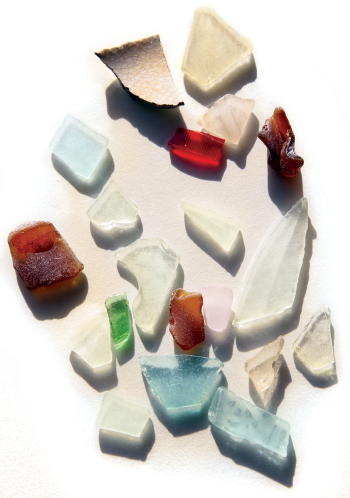
PAT SHINN THINKS THE BEST STRATEGY for collecting beach glass is to simply walk the beach, and as often as you can swing it. His best finds — and over the years, he and his wife Carleen have amassed some 30 pounds, one tiny nugget at a time — came while meditatively listening to the waves and catching a colorful glimpse by happenstance.
“The beach is our sanctuary,” the Ludington-based speech therapist and educator says. “Looking for beach glass isn’t the goal, but it’s like frosting on the cake.”
Beach or sea glass, depending on where you’re looking (beach glass/freshwater; sea glass/salt), is also nature’s ultimate recycler.
Michigan’s most common beach glass colors — white and brown — for the most part started as tourist trash some 20 to 50 years earlier; that’s how long it takes for waves to work the rough edges off what began as bottles of soda or beer. Less common aqua and cobalt blues often were once Milk of Magnesia or pharmaceutical bottles; rarer pastels, perhaps parts of broken Depression glass tossed out with the village trash.
Persistence (i.e., frequent beach walking) was key to the vast multi-colored trove of Evon Cram, 93, of Traverse City, a collection sometimes transformed into vacation art projects by children and grandchildren. And that’s even more important, she notes, as plastics have replaced bottles as container material of choice and an anti-pollution ethic kept beaches cleaner.

Beach glass scarcity has also kicked in a world-wide collector mania, shares Valerie Weston, vice-president of the North American Sea Glass Association, raising prices for finds, sometimes a hundred-fold. Whole clubs revolve around identifying the sources of rare finds or collecting of glass that glows under ultraviolet lights.
Her native Michigan, Weston notes, remains a hot spot for general collecting, though. Lake Erie is known nationwide for its beach glass abundance, perhaps due to the many industrial cities along its shores. Mackinac Island’s unexpected advantage is its general lack of beach and fact most visitors stick to paved pathways, leaving good finds for those who explore a bit closer to the waves.
One online forum cites frequent finds along Torch Lake near Alden; Boat Beach near St. Joseph; Warren Dunes State Park in Sawyer; Magoon Creek near Manistee and Lakeside Beach in Port Huron.
Lake Superior gives up its wave-tumbled treasures, too, particularly after storms. Beach glass artist Allyson Schwartz of Riverstone Gallery in Sault Ste. Marie finds riches of aqua (and other) glass on the Lake Superior side of the Soo Locks. She speculates the source was canning jars tossed overboard from ships, likely when captains had to portage around the falls.
“We find such cool and unusual things when walking the beach,” she says. “The tiny crystal beach glass pieces we call fairy tears.”
Likely Sources

Red (extremely rare): Lantern and traffic light lenses, automobile tail lights, perfume bottles and some types of old beer bottles, such as those made by Anchor Hocking for Schlitz Beer in the 1950s;
Cobalt blue (very rare): Apothecary products including Vick’s Vapo Rub, Milk of Magnesia, Nivea, Noxema and Bromo Seltzer; some prescription bottles and perfumes;
Pinks, lavenders, purples, lime greens (rare): Items like perfume bottles and art glass; many lavenders and pinks come from what was originally clear glass that was clarified with magnesium (lavender) or selenium (pink);
Greens, browns and aquas: Beer, soda, shampoo, Clorox bleach and wide array of other bottles (beachglassjewelry.com).







Facebook Comments